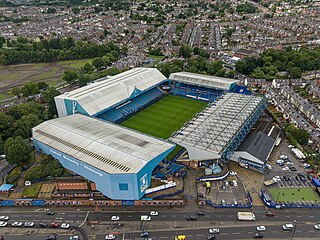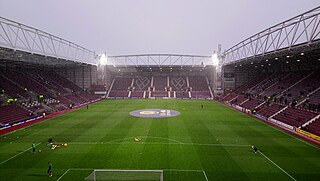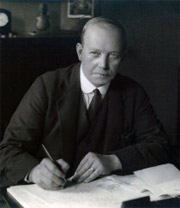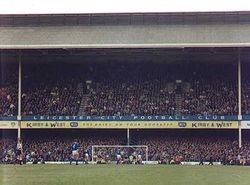
Hillsborough Stadium is a football stadium in Sheffield, England. It has been the home of Sheffield Wednesday since opening in 1899.

Anfield is a football stadium in Anfield, Liverpool, England, which has a seating capacity of 60,725 making it the fifth largest football stadium in England. It has been the home of Liverpool F.C. since their formation in 1892. It was originally the home of Everton from 1884 to 1891, before they moved to Goodison Park after a dispute with the club president.

Leicester City Football Club is an English professional association football club based in Leicester, East Midlands. They compete in the EFL Championship, the second level of the English football league system.

Maine Road was a football stadium in Moss Side, Manchester, England, that was home to Manchester City Football Club from 1923 to 2003. It hosted FA Cup semi-finals, the Charity Shield, a League Cup final and England matches. Maine Road's highest attendance of 84,569 was set in 1934 at an FA Cup sixth round match between Manchester City and Stoke City, a record for an English club ground.

Valley Parade, known as the University of Bradford Stadium for sponsorship reasons, is an all-seater football stadium in Bradford, West Yorkshire, England. Built in 1886, it was the home of Manningham Rugby Football Club until 1903, when they changed code from rugby football to association football and became Bradford City. It has been Bradford City's home since, although it is now owned by former chairman Gordon Gibb's pension fund. It has also been home to Bradford for one season, and Bradford Bulls rugby league side for two seasons, as well as host to a number of England youth team fixtures.

Pittodrie Stadium, commonly referred to as Pittodrie, is an all-seater stadium in Aberdeen, Scotland. Used primarily for football, it has been the home ground of the Scottish Professional Football League (SPFL) club Aberdeen F.C. since they were formed in 1903. Prior to then, the ground hosted the original Aberdeen F.C. from 1899 until the merger that created the present club.

Spion Kop is a colloquial name or term for a number of single-tier terraces and stands at sports stadiums, particularly in the United Kingdom. The steep nature resembles the Spion Kop, a hill near Ladysmith, South Africa, which was the scene of the Battle of Spion Kop in January 1900 during the Second Boer War.

White Hart Lane was a football stadium in Tottenham, North London and the home of Tottenham Hotspur Football Club from 1899 to 2017. Its capacity varied over the years; when changed to all-seater it had a capacity of 36,284. The stadium was fully demolished after the end of the 2016–17 season.

Tynecastle Park, also known as Tynecastle Stadium, is a football stadium in the Gorgie area of Edinburgh, which is the home ground of Scottish Professional Football League club Heart of Midlothian (Hearts). A UEFA category four stadium, it has also hosted Scotland international matches, and been used as a neutral venue for Scottish Cup and Scottish League Cup semi-finals.

St Andrew's, known for sponsorship reasons as St. Andrew's @ Knighthead Park, is an association football stadium in the Bordesley district of Birmingham, England. It has been the home ground of Birmingham City Football Club for more than a century.

King Power Stadium is a football stadium located in Leicester, in the East Midlands of England. It has been the home of EFL Championship club Leicester City since 2002 and was the stage as the club famously lifted the Premier League title in 2016. Situated alongside the River Soar, the all-seater stadium has a capacity of 32,262 and since 2021 has also been the primary home of Leicester City Women.

Bloomfield Road is a football stadium in Blackpool, Lancashire, England, which has been the home of Blackpool Football Club since 1901. It is the third stadium in the club's existence, the previous two being Raikes Hall Gardens and the Athletic Grounds.

Welford Road is a rugby union stadium in Leicester, England, and is the home ground of Leicester Tigers. The ground was opened on 10 September 1892, and is located between Aylestone Road and Welford Road on the southern edge of the city centre. The ground was developed in two main periods: either side of the First World War stands were built on both sides, and then between 1995 and 2016 both ends were developed and the north side redeveloped. The stadium has a capacity of 25,849, making it the largest purpose-built club rugby union ground in England. It hosted five full England national team matches between 1902 and 1923, and staged a single match at both the 1991 and 1999 Rugby World Cups.

Archibald Keir Leitch was a Scottish architect, most famous for his work designing football stadiums throughout Great Britain and Ireland.

London Road, currently known as the Weston Homes Stadium for sponsorship reasons, is a multi-purpose stadium in Peterborough, England. The stadium is in Fletton, south of the River Nene. It is currently used mostly for football matches and is the home ground of Peterborough United. The stadium holds 12,965 and was built in 1913, though the present ground bears no resemblance to the original following several periods of redevelopment.

Saltergate, officially the Recreation Ground, was the historic home of Chesterfield Football Club, and was in use from 1871 until the club's relocation in July 2010, a 139-year history that made it one of the oldest football grounds in England at the time of its closure. From the 1920s onward the name 'Saltergate' became predominant in popular references to the ground.

Aylestone Road, now also known as the Leicester Electricity Sports Cricket Ground, is a cricket ground in Leicester, England, which was the headquarters of Leicestershire County Cricket Club from 1901 to 1939. Although the playing area is much reduced by housing and commercial developments, it is still used as a cricket ground, though not by the county team.
A large number of English football clubs have ongoing schemes to redevelop existing grounds, or to move to newly constructed stadiums. A trend towards all-seater stadiums was initially prescribed by the Taylor Report, and was originally a condition only of Premier League admission. It has now become a requirement that within three years of a club's first promotion to the Championship all paying spectators are seated, even if the club is subsequently relegated. This page provides an (incomplete) list and description of those clubs who have planned new stadiums or refurbishments, or who have already moved/refurbished since around the time of the Taylor Report.
The 1998–99 Football League Cup was the 39th staging of the Football League Cup, a knockout competition for England's top 92 football clubs.






















